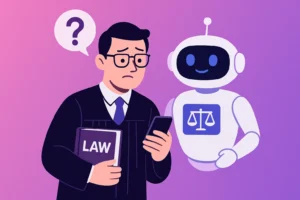“Building a legal info AI assistant for your law firm is easier than you think. Learn how to create and customize an AI legal assistant platform to improve client communication and boost efficiency with this practical guide.”
Building a legal AI assistant for your firm is a decisive step towards modernizing your practice. This guide gives you a clear path forward. It focuses on creating a tool that provides accurate legal info, improves client contact, and makes your firm more effective. We’ll cover the necessary steps. We will start by defining what your assistant should do. Then we will move on to training it with legal knowledge. Finally, we will cover how to keep things compliant with privacy rules. By the end, you’ll know exactly how to get this technology working for you.
Understanding the Power of AI in Legal Practice
AI is changing the legal world fast. Think of it as a force multiplier for lawyers. It doesn’t replace them. Instead, it handles repetitive tasks. This frees up time for complex legal work. A good Legal Info AI Assistant does a lot of things. It can answer common client questions. It can also help with research. It can manage schedules. This makes your team more efficient. It also gives clients a better experience. They get quick answers. This makes them feel heard and cared for.
Firms that use AI get a real edge. They can take on more cases and reduce their overhead. It’s about working smarter, not just harder. AI can process vast amounts of data and find patterns humans would miss. This leads to better legal strategies. It’s a game-changer for firms of all sizes.
Step 1: Define the Assistant’s Scope and Purpose
The first step is about focus. You need to know precisely what you want your AI assistant to do. Don’t try to make a tool that does everything; that will result in a tool that does nothing well. Instead, pick a specific area.
Start with a brainstorming session. Ask your team what their most significant pain points are. Are they spending hours on client intake forms? Do they answer the same questions over and over? Is a lot of time spent on simple research tasks? The answers will show you where an AI assistant can help most.
Here are some everyday use cases:
- Client Communication: Answering FAQs about a specific practice area. This can include questions about divorce law, estate planning, or personal injury claims.
- Internal Knowledge Base: A tool for lawyers and staff. It helps them quickly find case summaries, legal precedents, or internal firm policies.
- Document Analysis involves scanning documents to find key clauses, dates, or names. It can also help with contract review.
Pick one area to start. This makes the project manageable. It also gives you a chance to see the value right away. Once you see it working well, you can add more features later. This phased approach reduces risk. It also keeps your team engaged with the project.
Step 2: Collect and Prepare Your Legal Knowledge
An AI is only as good as the data it learns from. This is especially true in law. Your assistant needs to be trained in proper legal knowledge. This step takes time. It’s also the most essential part of the process.
You will need to gather your firm’s documents. This can include:
- Case Law: Relevant court decisions and legal precedents.
- Statutes and Regulations: The laws that apply to your practice areas.
- Internal Documents: Your firm’s best practices, intake forms, and successful case examples.
- Client FAQs: These are the most common questions you get from clients and the correct answers.
Once you have the documents, you need to clean them up. Make sure the text is clear and easy to read. Remove any personal client information. This is a critical step for privacy. You also need to organize the data. Group similar documents together. This helps the AI learn more effectively.
You might need to convert different file types. PDFs, Word documents, and text files must be in a consistent format. If you don’t already have a system for document management, this is a good time to create one. Good data organization helps both your AI and your human team.
Step 3: Train the AI on Your Firm’s Data
With your data ready, it’s time for training. This is where the AI learns from the knowledge you collected. Most modern platforms let you do this easily. You just upload the documents. The platform’s AI models then analyze the text.
The training process works in a few ways. The AI learns the relationships between words and concepts. It starts to understand the language of law. It also knows how to connect questions with the correct answers in your documents. The more high-quality data you provide, the brighter your assistant becomes.
It’s not a one-time thing. The law changes. Your firm’s knowledge base grows. So, you need to update the AI regularly. Make it a habit. Add the information to your training data when you get a new case or a new law is passed. This keeps your assistant accurate and valuable.
A good AI platform also lets you fine-tune the training. You can correct wrong answers and give feedback on what worked and what didn’t. This interactive process improves the AI assistant, making it a customized tool for your firm.
Step 4: Ensure Privacy and Compliance
Legal data is sensitive. Protecting it is not optional. It is a must. You must ensure your AI assistant follows all privacy laws, including GDPR in Europe or state-specific laws in the US.
Here are the key points to consider:
- Data Security: Make sure the platform you use is secure. Your data should be encrypted and stored on secure servers.
- Access Control: Not everyone should have access to the AI’s data. Set up permissions. Ensure that only authorized staff can see sensitive information.
- Data Minimization: Train the AI on only the data it needs to do its job. Don’t use a client’s entire file if you only need a small part.
- Clear Disclaimers: When the AI assistant talks to clients, it must be clear about what it is. It should say it is an AI and not a lawyer. It should also state that its information is not legal advice. This is a legal and ethical requirement.
Failing to protect privacy can have serious consequences, including fines and damage to your firm’s reputation. So, put a lot of thought into this step. Work with your IT security team and make sure everything is locked down.
Step 5: Test, Refine, and Launch
Once the AI is trained and secure, you need to test it. This is where you find out if it works.
Start with a small group. Have a few lawyers or paralegals test it out. Give them a list of questions to ask. The questions should cover a range of topics and include some hard questions. This will show you where the AI excels and where it needs work.
Pay close attention to the answers. Are they accurate? Are they easy to understand? Does the assistant give wrong information? If it does, go back to your training data. See if you can add more information to correct the mistakes. This is a cycle of testing and refining. You keep doing it until you are happy with the results.
After the internal test, you can do a limited launch. Let a small group of friendly clients use it. This gives you real-world feedback. Their questions and comments will be invaluable. They will show you how people use the tool.
When you are ready, you can fully launch your new assistant. Market your new assistant to your clients. Explain how it will help them. Tell them it gives them quick access to information. This shows your firm’s innovation and enables you to get a return on your investment in the tool.
Case Study: A Small Firm’s AI Success
A family law firm was struggling with client intake. Their staff spent a lot of time on calls answering the same basic questions, such as “What are the grounds for divorce?” or “How does child custody work?”
They built an AI assistant. They trained it on their specific FAQs, local laws, and articles they had written. They made sure the assistant had a clear disclaimer. It said it was not a substitute for legal advice.
The result was excellent. The AI assistant handled about 70% of the initial client questions, freeing up their paralegals to focus on more detailed casework. The clients loved it, too. They could get answers at any time, even after hours. The firm saw a significant increase in client satisfaction and a big jump in new clients. The AI assistant was a key part of their growth.
Introducing Scalewise AI: Your Path to Innovation
You may wonder where to start if you want to build this tool. You need a platform that is easy to use and powerful. This is where Scalewise AI comes in. It’s a user-friendly platform lets your firm create, customize, and share its AI agents.
Scalewise AI makes it simple. You don’t need a tech team. The platform has an intuitive interface. It walks you through each step. You can upload your documents and train your AI agent with just a few clicks. This means you can get started right away.
The platform is also highly customizable. You can adjust the AI’s tone and personality, ensuring the assistant is part of your firm. You can also name it, personalizing the experience for your clients.
One of the best features is the public marketplace. You can share your AI assistant there. Other firms can find it. You can also find assistants built by different firms. This lets you access a whole new range of legal tools. This marketplace creates a community of innovation. It helps everyone in the legal field benefit from AI.
Scalewise AI gives you the tools to create a powerful Legal AI chatbot. It lets you build a complete AI legal assistant platform. It has all the features you need for AI-driven legal support. It makes legal tech innovation simple and accessible.
It’s the best choice for firms ready to move forward. It helps with AI for client communication. It makes customizable AI agents a reality. It truly is the best way to start with AI-powered legal services.
FAQs
Q1: What exactly is a Legal Info AI Assistant?
An AI assistant is a software tool that uses artificial intelligence to perform specific tasks. In a law firm, it can answer questions based on a particular set of knowledge. It can also help with research or document review. It’s not a lawyer. It is a tool that allows lawyers and clients to get information faster.
Q2: Will a Legal AI Assistant replace my lawyers?
No, it will not. An AI assistant handles simple, repetitive tasks. It is there to support lawyers. It takes over things like answering FAQs. This frees up lawyers to do high-level legal work. It makes them more efficient. It does not replace their legal judgment or client relationships.
Q3: How do I make sure the AI gives accurate answers?
Accuracy depends on the data. You must train it with high-quality, up-to-date legal documents. You also need to test it often. You should check its answers. Then, you can correct any mistakes. This ongoing process of training and testing ensures accuracy.
Q4: Is client data safe with an AI assistant?
This is a key concern. You need to use a secure platform with strong access controls. You must also be careful about the data you feed it. Do not include personal client information in your training data. Always make sure you comply with privacy laws like GDPR.
Q5: What are the benefits of using an AI assistant?
There are many benefits. You will save a lot of time. Your team can focus on more important work. Client communication will improve. Clients get fast answers. This boosts their satisfaction. Your firm will also seem more modern and innovative. It gives you a real competitive advantage.
Q6: How much does it cost to build a Legal AI Assistant?
The cost varies greatly. It depends on the platform you choose. Some platforms, like Scalewise AI, are free to get started. Other options can be costly. The cost also depends on the complexity of your project. Starting small helps keep costs down. You can always add more features later.
Q7: Can a single AI assistant handle different practice areas?
Yes, it can. You can train one AI assistant on different types of law. It’s often better to start with one practice area. This lets you get a feel for the process. Then, you can add more practice areas over time. You can also build separate AI agents for each location. This can help with organization.
Q8: What if the AI gives the wrong legal advice?
It is a machine. It does not give legal advice. It provides legal information based on its training data. You must have a clear disclaimer. This disclaimer must tell clients that it is not a lawyer. It must say the information is not a substitute for legal advice from a human lawyer. This is vital for legal and ethical reasons.
Q9: Can I use this assistant on my website?
Yes, you can. Most platforms let you embed the AI assistant on your website. This makes it easy for clients to find and use it. You can also use it internally. You can make it a part of your firm’s intranet. This helps your lawyers and staff.
Q10: What are the first steps to take?
Start with a plan. Define what you want your AI assistant to do. Then, gather your legal documents. Organize them. Pick a platform like Scalewise AI. Start with a small pilot project. Test it. Get feedback. Then, you can expand its use.
Q11: How long does it take to build?
The time frame varies. It depends on the size of your firm. It also depends on the amount of data you have. A simple assistant can be ready in a few weeks. A more complex one might take months. Using an easy platform like Scalewise AI can speed up the process.
Q12: What kind of information should I use for training?
Use a lot of different documents. Include case law. Add statutes and regulations. Include internal policies and forms. You should also use your firm’s own articles or blog posts. The more diverse the high-quality data, the better the AI will perform.
Q13: How can I make my AI assistant sound more like a human?
You can customize its persona. Many platforms let you set the tone. You can make it sound formal or more conversational. You can also give it a name. This makes it feel more personal. You want it to reflect your firm’s brand and values.
Q14: How does AI help with document analysis?
AI can scan documents fast, find key terms, dates, and names, and highlight essential clauses, saving lawyers hours. It is a powerful tool for due diligence and contract review, spotting things a human might miss.
Q15: Can the AI assistant help with client intake?
Yes, it can. It can ask potential clients initial questions. It can collect basic contact info. It can also explain your firm’s services. This helps you qualify leads before a lawyer even talks to them. It makes the intake process much smoother.
Q16: Is it an “AI chatbot” or an “AI assistant”?
The terms are often used interchangeably. A chatbot usually focuses on conversational tasks, while an assistant can do more complex things. It might help with research or document analysis. Your tool can be both—a chatbot that acts as a powerful assistant.
Q17: What is the main benefit of the Scalewise AI marketplace?
The marketplace is great for sharing. You can let others use your tools. You can also find tools that other firms have built. This creates a community. It means you don’t have to make everything yourself. You can find pre-built assistants for specific legal tasks.
Q18: What is “legal knowledge automation”?
This is using technology to automate tasks that rely on legal knowledge. An AI assistant is a great example. It automates finding and providing legal information, making the firm more efficient and modern.
Q19: Can an AI assistant help with billing questions?
Yes, it can. If you train it on your billing processes, it can answer common questions. For example, it can explain how billing works and help clients understand their invoices, reducing the number of calls your staff gets about billing.
Q20: What is the difference between a general AI and a specialized one?
A general AI is like a jack-of-all-trades. It knows a little about everything. A specialized AI is an expert. It is trained in a specific field, like law. It knows a lot about a narrow topic. A specialized AI is much more valuable and accurate for a law firm. It can give more detailed and relevant information.





